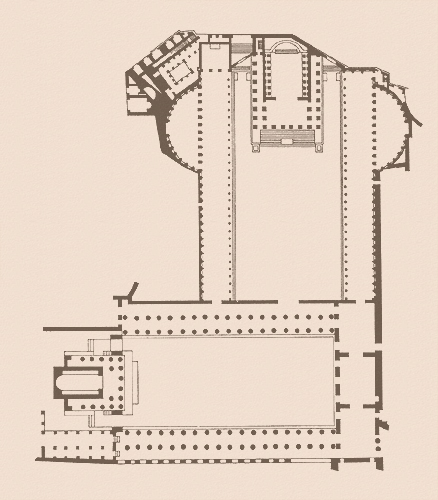

"The Avenger descends himself from heaven to behold his own honours and his splendid temple in the forum of Augustus. The god is huge, and so is the structure: no otherwise ought Mars to dwell in his son’s city....The god of arms surveys the pinnacles of the lofty edifice, and approves that the highest places should be filled by the unconquered gods....He beholds, too, the name of Augustus on the front of the temple; and the building seems to him still greater, when he reads the name of Caesar."
Ovid, Fasti (V.551ff)
Ovid attests that the mythical ancestors of Augustus were placed in the exedrae, hemicycles or semi-circular apses that open behind the colonnade of the porticoes. The back wall of the porticoes and the curved walls of the hemicycles were articulated with engaged columns that framed a series of rectangular niches that held portrait busts representing the dual ancestry of Augustus.
In the northwest exedra were the gens Julia, including a statue of Aeneas in the central niche. The descendent of Venus, he represented pietas or piety. Carrying his aged father and holding the hand of his son, he led them away from burning Troy. On either side are thought to have been his descendants: the legendary kings of Alba Longa, which had been founded by Aeneas' son, and where Romulus and Remus were said to have been born.
In the southeast exedra were the heroes of Rome's past. A statue of Romulus, bearing spolia opima (the arms of a defeated enemy won in single combat), represented virtus or courage, which Augustus now claimed for himself. Filling the niches on either side were the principes and triumphatores of the Republic, whose statues may have continued down the colonnaded porticoes, their deeds and achievements recorded in inscriptions that served as models of conduct for future generations (Suetonius, XXXI.5). By this pedigree, Augustus associated himself with Aeneas and Venus, his divine mother, and with Romulus, the son of Mars and founder of Rome. The pietas of Aeneas is suggested in Augustus having avenged Caesar's death, the virtus of Romulus in his recovering the standards lost to the Parthians and now dedicated in the new temple.
The exedrae, which were used again a century later in the Forum of Trajan, open the area in front of the temple and provide a more expansive sense of space and light. The assumption is that they were roofed, with windows cut in the clerestory above the portico to allow in light, although it is possible that the interior still would not have been sufficiently illuminated to display the program of statues and inscriptions within. Nor would the richness of the polychrome marble paving have been seen to full effect in the subdued light. Ovid describes the Temple of Mars from the perspective of the god himself, who has descended to survey the completion of Augustus' vow. When he speaks of Mars looking down from the pediment of the temple to see both Aeneas and ancestors of the Julian clan, it is presumed that they were visible from that perspective. It may be, then, that the exedrae were not roofed.
It is yet another reminder that much of what is known about the Forum of Augustus, only half of which has been excavated, is conjecture and often based on a line of text or fragment of stone. Even what does survive may not permit an accurate reconstruction so much as a hopeful visualization.
In the ground plan above, the Temple of Mars Ultor is situated at the back of a rectangular courtyard, flanked by colonnaded porticoes, as is the Temple of Venus Genetrix in the Forum Julium, after which the forum is modeled. Suetonius (LVI) records that it was narrower than had been planned because Augustus was reluctant to dispossess the owners of neighboring houses, but it is more likely that he simply was not able to purchase all the land he needed. Or it may be that the Vicus Longus, which passed behind the forum, did not admit to any expansion. This may explain the lack of symmetry of the rear wall, an irregularity that was concealed by the long porticoes.
The axis that passes through the center of the exedrae and the façade of the temple focuses attention on the piazza in front, where there was a statue of Augustus in a four-hour chariot (quadriga) erected by the Senate in his honor, declaring him pater patriae, father of the country, as Augustus records in his Res Gestae (XXXV).
Reference: Ovid: Fasti (1936) translated by James G. Frazer (Loeb Classical Library); A New Topographical Dictionary of Ancient Rome (1992) by L. Richardson, Jr.; Roman Art: Romulus to Constantine (1995) by Nancy H. Ramage and Andrew Ramage; Playing with Time: Ovid and the Fasti (1995) by Carole E. Newlands.
![]()